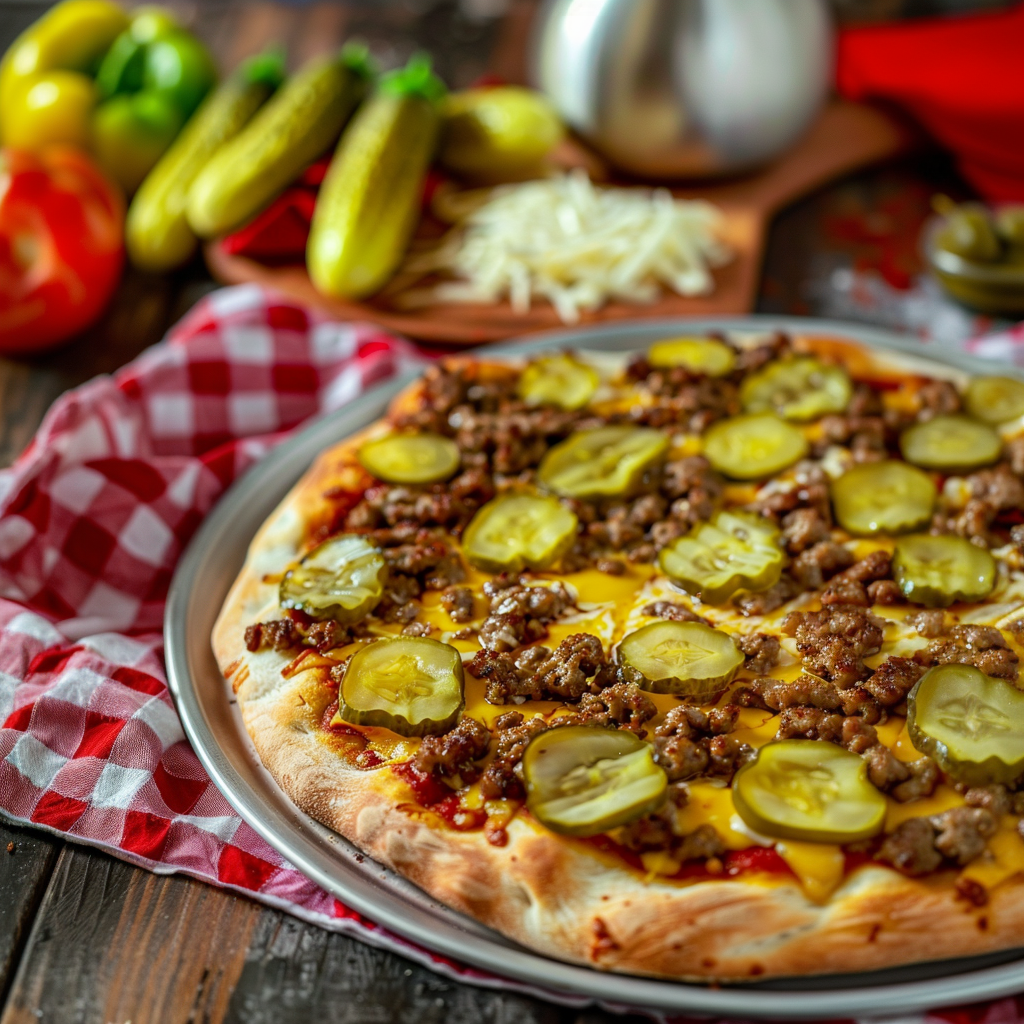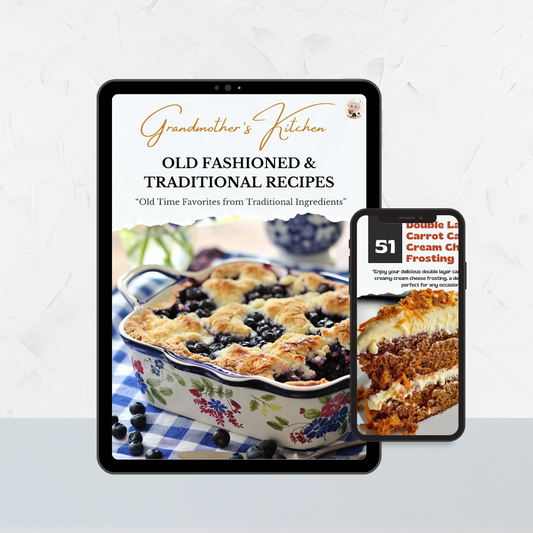Cheeseburger Pizza: A Fun and Flavorful Twist on a Classic

Share
When I Realized a Pizza Could Have the Flavor of a Cheeseburger
The first time I realized a pizza could taste like a cheeseburger was a game-changer, especially when my kids were young teenagers. They love both pizza and cheeseburgers, so combining the two was a no-brainer. I tried it out one day, thinking it would be a fun experiment, and it turned out to be a huge hit! Not only did my kids love it, but it was a great food to make whenever they had friends over. The pizza perfectly captures all the flavors of a classic cheeseburger, from the juicy ground beef to the sharp cheddar cheese, all topped off with tangy pickles. It’s now one of those recipes I keep in my back pocket because I know it’ll always be a winner, especially when there are hungry kids around.
Did You Know?
Cheeseburger pizza combines two beloved comfort foods into one delicious dish. The concept of combining the elements of a cheeseburger with the format of a pizza is said to have originated from inventive chefs looking to offer something unique and satisfying. This fusion dish captures the essence of a cheeseburger, with the tangy tomato sauce standing in for ketchup, ground beef mimicking the patty, and grated cheddar cheese replacing the usual cheese slice.
Yield: 1 pizza, 8 slices
Ingredients:
For the Crust:
- 2 1/4 tsp active dry yeast
- 1 1/2 cups warm water (110°F/45°C)
- 3 1/2 to 4 cups all-purpose flour
- 2 tbsp olive oil
- 1 tsp sugar
- 1 tsp salt
- or use a pre-made crust from the freezer section
For the Toppings:
- 1/2 lb ground beef
- 1 cup pizza tomato sauce
- 2 cups shredded cheddar cheese
- Dill pickle slices
Instructions:
Prepare the Crust:
Homemade Crust:
Dissolve yeast in warm water and let it sit for about 5 minutes until frothy.
Personal Tip: Make sure the water is the right temperature—not too hot, not too cold—to properly activate the yeast.
Add olive oil, sugar, and salt to the yeast mixture.
Personal Tip: Adding a little sugar helps feed the yeast, giving you a better rise in your dough.
Gradually add flour, mixing until a dough forms. Knead the dough on a floured surface for about 5-7 minutes until smooth and elastic.
Personal Tip: Knead until the dough is smooth but still slightly tacky to the touch for the perfect texture.
Place the dough in an oiled bowl, cover, and let rise in a warm place for about 1 hour or until doubled in size.
Personal Tip: A warm spot like the top of your fridge or inside an off oven with just the light on can help the dough rise better.
Punch down the dough and roll it out on a floured surface to fit your pizza pan or baking sheet.
Personal Tip: Roll the dough evenly to avoid thin spots that could burn during baking.
Pre-made Crust:
Follow the package instructions for thawing and preparing.
Personal Tip: Pre-bake the crust for a few minutes before adding toppings to prevent sogginess.
Prepare the Toppings:
Cook the ground beef in a skillet over medium heat until browned and fully cooked. Drain excess fat and set aside.
Personal Tip: Season the beef with a bit of salt and pepper while cooking for added flavor.
Assemble the Pizza:
Preheat your oven to 475°F (245°C).
Personal Tip: Preheating the oven ensures a crispier crust.
Spread the pizza tomato sauce evenly over the pizza crust.
Personal Tip: Use a spoon to spread the sauce, leaving a small border around the edges.
Sprinkle the cooked ground beef over the sauce.
Personal Tip: Distribute the beef evenly to get a bit in every bite.
Add the shredded cheddar cheese evenly over the beef.
Personal Tip: Mixing in some mozzarella with the cheddar can give a nice balance of meltiness and flavor.
Bake:
Place the assembled pizza in the preheated oven and bake for 12-15 minutes, or until the crust is golden and the cheese is bubbly and melted.
Personal Tip: Rotate the pizza halfway through baking for even cooking.
Garnish and Serve:
Remove the pizza from the oven and let it cool for a few minutes.
Personal Tip: Letting the pizza cool slightly makes it easier to slice and serve.
Top with pickle slices.
Personal Tip: Add the pickles just before serving to keep them crisp.
Slice and serve warm.
Personal Tip: Use a pizza cutter for clean, even slices.
Nutritional Information (Per Serving):
Calories, 320, Protein, 15g, Carbohydrates, 32g, Fiber, 2g, Net Carbohydrates, 30g, Fat, 15g, Saturated Fat, 7g, Cholesterol, 40mg, Sodium, 650mg, Sugars, 5g, Glycemic Index, Medium
Kitchen Tips, Great Ideas, How to Save Money:
- Pre-made Crust: Save time by using a pre-made crust from the freezer section.
- Lean Beef: Use lean ground beef to reduce fat content and improve healthiness.
- Cheese Variations: Mix in mozzarella with cheddar for a different flavor profile.
- Bulk Buying: Purchase ground beef in bulk and freeze portions for future use to save money.
- Homemade Sauce: Make your own tomato sauce with canned tomatoes, garlic, and herbs to control ingredients and reduce costs.
- Vegetarian Option: Substitute ground beef with plant-based meat alternatives for a vegetarian version.
- Custom Toppings: Add your favorite burger toppings like bacon bits, tomato slices, or onion slices.
- Storing Leftovers: Store leftover pizza in the fridge and reheat in the oven to maintain crispiness.
- Meal Prep: Make and freeze extra dough for quick and easy future pizza nights.
- Homemade Dough Savings: Making your own dough is often cheaper and more flavorful than store-bought options.
Let’s Learn About Flour for Pizza Dough
Flour plays a crucial role in making pizza dough, influencing its texture, rise, and flavor. Different types of flour have distinct properties that affect the dough.
All-purpose flour is a versatile option and produces a soft dough with a chewy crust. It has moderate gluten content, making it suitable for thin or pan pizzas.
Bread flour has a higher gluten content, leading to a chewier, more elastic dough. This type of flour is ideal for a traditional, crisp yet chewy pizza crust, giving the dough more strength and structure.
00 flour, an Italian flour often used in Neapolitan pizzas, is finely ground and contains less gluten than bread flour. It results in a soft, tender dough with a crisp exterior, perfect for high-temperature cooking, like wood-fired ovens.
When choosing flour for pizza dough, check the protein content, as higher protein flours create chewier doughs.


